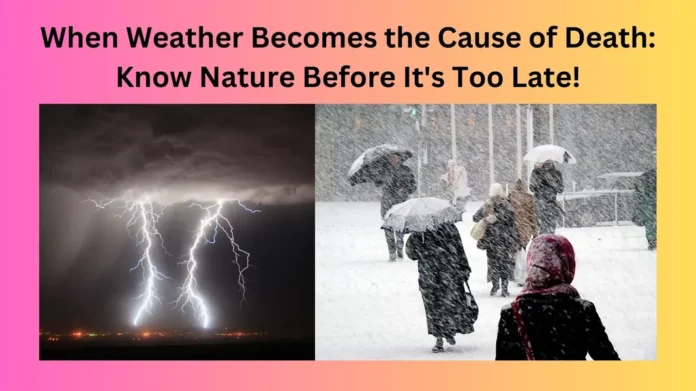Weather, the ever-changing force of nature, often captures our attention with its mesmerizing beauty and unpredictability. However, in some unfortunate instances, it transforms from a source of wonder to a lethal threat.
Understanding the nuances of nature becomes crucial when extreme weather conditions turn fatal. In this article, we’ll explore the ways in which weather can become the cause of death, emphasizing the importance of knowing and respecting nature before it’s too late.
The Unseen Menace of Heatwaves
Understanding the Silent Killer
As temperatures soar to unprecedented levels, heatwaves are becoming increasingly lethal. This section explores the hidden dangers of extreme heat, from heat-related illnesses to the impact on vulnerable populations. How well do we really know the signs of heat exhaustion, and what measures can be taken to prevent its fatal consequences?
Rising Tides: The Threat of Floods
Nature’s Fury Unleashed
When heavy rains and storms strike, the risk of flooding escalates. This section delves into the devastating impact of floods on both human lives and infrastructure. What role does climate change play in the increasing frequency of floods, and how can communities prepare for these watery disasters?
3. A Blizzard’s Silent Fury
Surviving the Icy Grip of Winter
Winter, with its picturesque snowscapes, can also be deadly. Explore the dangers posed by blizzards, frostbite, and avalanches. How can individuals stay safe during extreme winter conditions, and what lessons can be learned from historical incidents?
4. The Wrath of Hurricanes and Typhoons
Navigating the Storm
Hurricanes and typhoons, colossal storms with destructive potential, claim lives and alter landscapes. This section discusses the science behind these weather phenomena and explores the best practices for surviving their impact. How can communities prepare for these extreme events, and what are the long-term consequences for affected regions?
5. Lightning Strikes: Nature’s Electric Fury
The Shocking Truth
Lightning, a seemingly beautiful display of nature’s power, can swiftly turn deadly. This section examines the science behind lightning strikes and offers safety tips for avoiding these electrifying hazards. What are the statistics on lightning-related deaths, and how can individuals stay safe during thunderstorms?
6. Droughts: A Slow-Motion Disaster
When Water Becomes a Rarity
While not as visually dramatic as other weather events, droughts silently claim lives and devastate ecosystems. This section explores the long-term consequences of droughts, from food shortages to conflicts over water resources. How can societies adapt and mitigate the impact of prolonged dry spells?
7. Tsunamis: The Ocean’s Roar
Waves of Destruction
Tsunamis, triggered by seismic activity, can unleash waves of destruction along coastlines. This section delves into the science of tsunamis and explores the importance of early warning systems. How can coastal communities prepare for the unpredictable force of these massive ocean waves?
8. Tornadoes: Twisting Menace
The Dance of Destruction
Tornadoes, with their swirling winds, leave a path of devastation in their wake. This section explores the characteristics of tornadoes and offers guidance on tornado preparedness. How do tornadoes form, and what safety measures should individuals take when facing the threat of a tornado?
Conclusion
In the face of nature’s potential for deadly force, it’s essential to educate ourselves about the risks posed by various weather conditions. Whether it’s the scorching heat of summer, the freezing chill of winter, or the destructive power of storms, being prepared can mean the difference between life and death. By understanding and respecting nature, we empower ourselves to navigate its unpredictable terrain safely.
FAQs
Q1: Can extreme weather events be attributed to climate change?
Yes, many extreme weather events are linked to climate change, which intensifies the frequency and severity of phenomena like hurricanes, heatwaves, and floods.
Q2: How can I protect myself during a heatwave?
Stay hydrated, avoid prolonged sun exposure, and seek shade when possible. Wear light-colored and loose-fitting clothing to help your body cool down.
Q3: Are tornadoes more common in certain regions?
Tornadoes can occur worldwide, but they are most frequent in the central United States, known as Tornado Alley, due to the unique convergence of weather patterns.
Q4: What precautions should be taken during a flood?
Move to higher ground, avoid flooded areas, and have an emergency kit ready. Stay informed through weather updates and heed evacuation orders.
Q5: How do early warning systems for tsunamis work?
Early warning systems use seismic sensors to detect underwater earthquakes and issue alerts to coastal areas, providing valuable time for evacuation.
In conclusion, as we witness the growing impact of climate change, understanding the dangers posed by various weather conditions becomes paramount. By respecting nature and implementing preventive measures, we can safeguard ourselves and our communities from the potentially lethal consequences of extreme weather events. Stay informed, stay prepared, and let’s ensure that we know nature before it’s too late!















